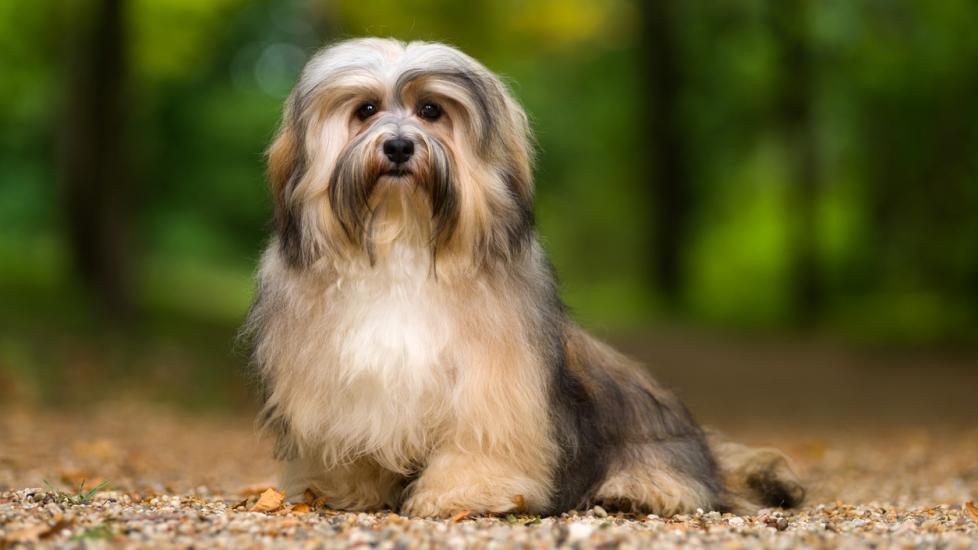Havanese
iStock/Dorottya_Mathe
The Havanese is an energetic and entertaining toy breed belonging to the Barbichon family of dogs, which also includes the Bichon Frise, Bolognese and Maltese. Standing just under a foot tall, a full-grown Havanese weighs between 7–3 pounds.
Once known as the Havana Silk Dog or the Spanish Silk Poodle, the Havanese is the only dog breed native to Cuba. According to the Havanese Club of America, the ancestors of today’s breed were brought from Spain to Cuba in the 1600s.
During the Cuban Revolution in the 1950s, some Cubans fled to the U.S.—bringing these little dogs with them.
Caring for a Havanese
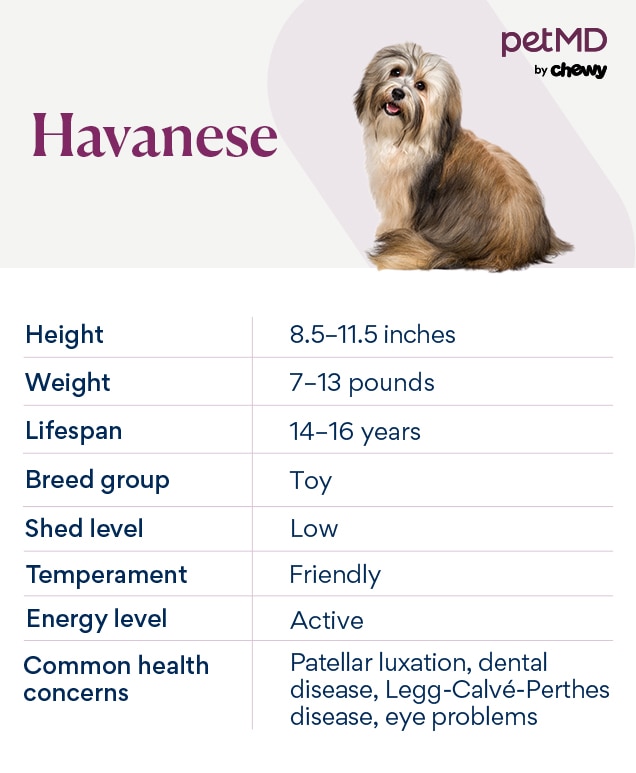
The Havanese dog is smart, spirited, and highly trainable. They make good companion dogs but may bark excessively if not properly trained.
Their long coat can be straight or wavy and requires frequent brushing to stay tangle-free. Don’t bring home a Havanese puppy if you’re not ready to spend time every day on their grooming (though, shorter Havanese haircuts can make brushing more manageable).
Like all dogs, the Havanese breed does best with daily walks and a moderate amount of playtime. Aim for 30 minutes of total daily exercise, which can be broken out into 10-minute walks or play sessions.
Havanese Health Issues
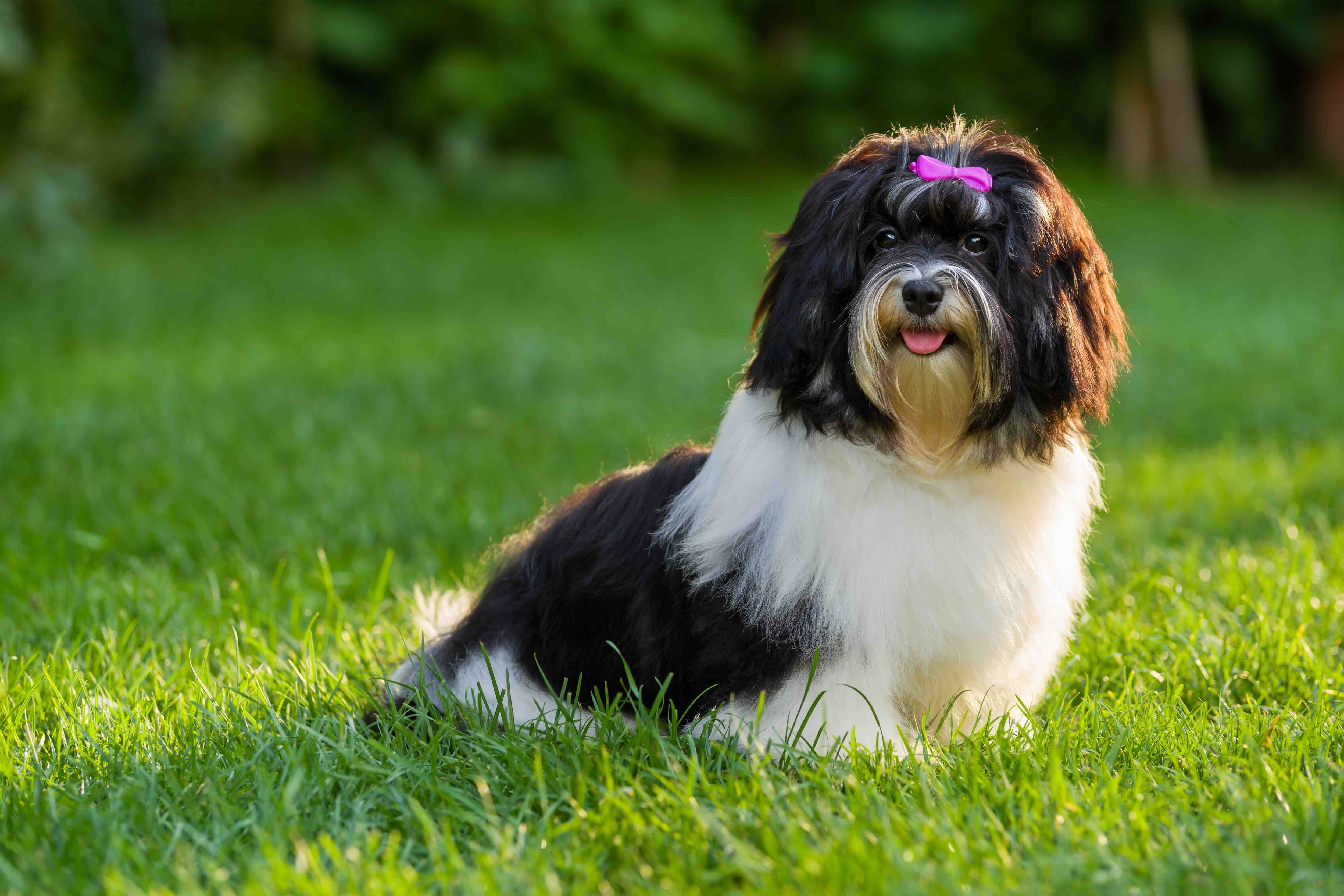
The average Havanese lifespan is 14–16 years, and they’re typically a healthy dog breed. But, like all dogs, Havanese are predisposed to a handful of medical conditions.
Progressive Retinal Atrophy
Progressive retinal atrophy (PRA) is a group of diseases that cause the photoreceptor cells (rods and cones) on the retina to break down. Initially, the Havanese may have difficulty seeing in the dark, but over time the condition will result in complete blindness.
In most cases, PRA is an inherited disease, so dogs with this condition should not be bred. There are currently no effective treatments available.
Legg-Calve-Perthes Disease
Legg-Calve-Perthes disease is a condition in which the head of the femur breaks down. As the bone breaks down, pain and limping can occur.
Legg-Calve-Perthes occurs in young dogs, mostly in Havanese puppies less than 18 months of age. In some cases, pain can be controlled with medications. In severe cases, surgery may be recommended.
Patellar Luxation
The patella (kneecap) is a small bone that normally sits in a groove within the femur at the knee. In dogs with patellar luxation, the patella moves (luxates) outside of its assigned groove. This inappropriate movement can cause discomfort and may lead to arthritis.
Many pets will skip or run on three legs when the patella is out of place. In some cases, this may only last a few steps until the knee returns to its proper alignment. In more severe cases, the patella remains out of place.
In mild cases, joint supplements or anti-inflammatory medications are used to control pain and prevent arthritis. In the more severely affected dogs, surgery may be recommended.
Dental Disease
Dental disease is one of the most common conditions seen in dogs as they age, especially in small breeds like the Havanese. This is when bacterial tartar and plaque lead to inflammation of the tissues around the teeth and, eventually, to tooth and bone decay.
The best way to prevent dental disease is through daily tooth brushing with a dog-specific toothpaste and toothbrush.
Routine dental cleanings are recommended to evaluate the mouth, remove plaque and tartar, polish teeth (to prevent future buildup), and treat or extract teeth that are significantly unhealthy.
Just like with humans, dental disease can be a painful condition and may even affect the health of a dog’s internal organs.
What To Feed a Havanese
Feeding a commercial kibble or wet food compliant with the Association of American Feed Control Officials (AAFCO) standards is a good way to ensure your Havanese receives a complete and balanced diet.
Havanese puppies should be fed a diet formulated specifically for puppies or designated for “all life stages.” For adults, dental-focused diets, like Hill’s Prescription Diet t/d Dental Care, may be recommended by your veterinarian to help prevent dental disease.
Always talk to your veterinarian about the best dog food for your Havanese.
How To Feed a Havanese
As a toy breed, the Havanese dog breed will do best with two to three measured feedings per day. Havanese puppies should eat three to four small meals per day on a regular schedule to help maintain stable blood sugar (and prevent hypoglycemia).
How Much Should You Feed a Havanese
The recommended caloric intake varies from dog to dog and depends on your Havanese’s size, metabolism, spay or neuter status, and activity level.
The best way to determine how much to feed your dog is to discuss with your veterinarian, who can calculate specific needs. Additionally, the feeding guide labels on dog food packaging provides valuable information for pet parents.
Take care to not overfeed your Havanese, especially because excess weight puts extra strain on joints like the knee. And remember that calories in dog treats add up quickly!
Nutritional Tips for Havanese
Havanese dogs require a balance of carbohydrates, proteins, and fats to stay healthy and lean. They may benefit from the addition of omega-3 fatty acids into their diets.
Omega-3 fatty acids can be found in skin and joint supplements, fish oil, and even in some specially formulated dog foods, such as Purina Pro Plan Salmon & Rice Formula. These fatty acids act as natural anti-inflammatories that help to support the Havanese’s skin, coat, kidneys, joints, and heart.
Always talk with your veterinarian before adding anything new to your dog’s diet, including supplements.
Behavior and Training Tips for a Havanese
Havanese Personality and Temperament
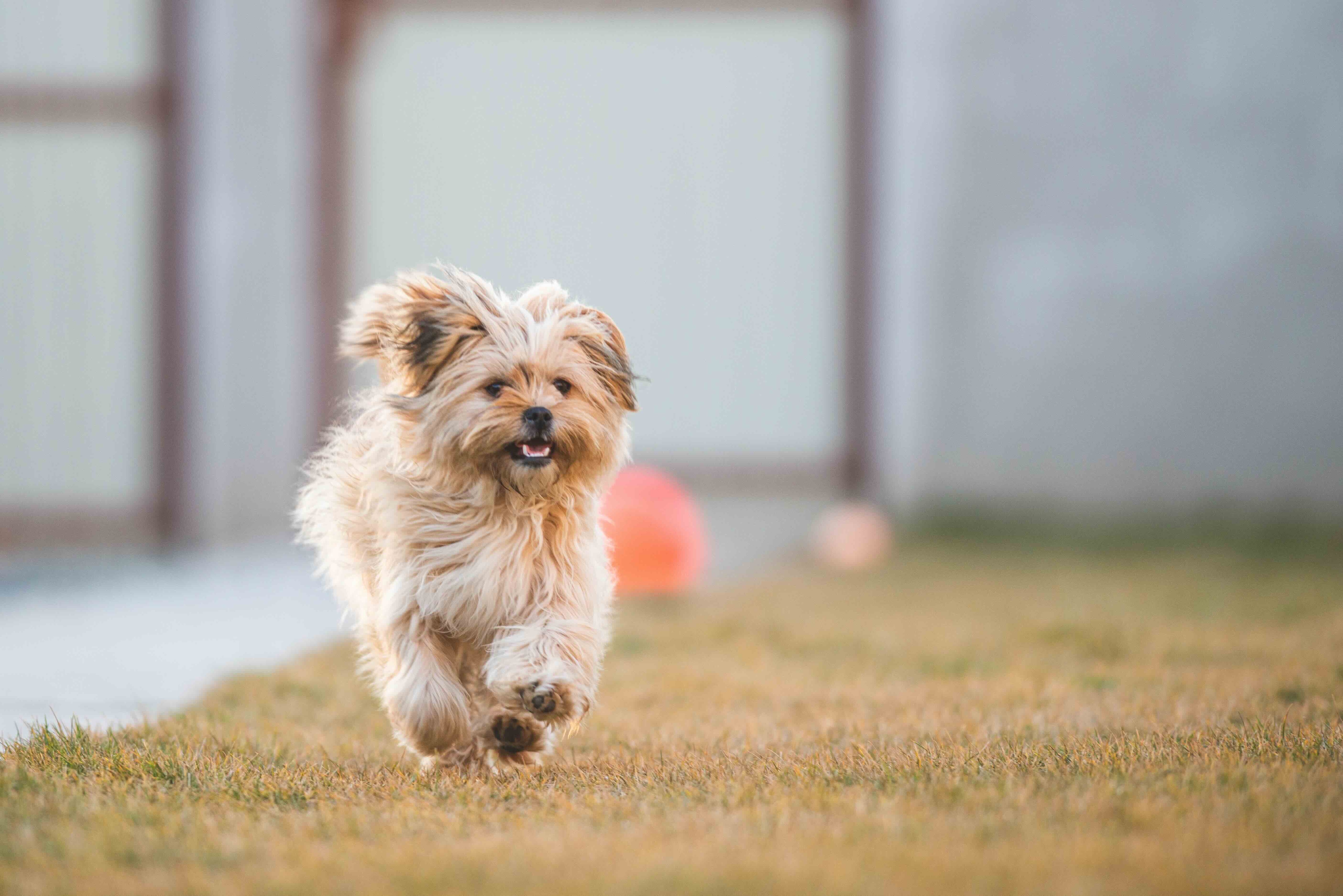
Havanese dogs are loving and intelligent pups with bright, outgoing personalities. They are exceptionally affectionate and usually well-behaved with children and other dogs when supervised, socialized, and trained from puppyhood.
Havanese Behavior
The Havanese bonds quickly with humans and dislikes being left alone, so pet parents can expect to be followed closely by this shiny-coated shadow. Some Havanese dogs may develop separation anxiety and may not tolerate being left alone in their crate all day.
If they’re taught not to bark excessively, these little pooches do well as apartment dogs.
Havanese Training
Havanese are exceptionally intelligent, which makes them relatively easy to train. These playful dogs will learn best when training games and positive reinforcement methods are used.
Like all breeds, Havanese should be socialized from a young age to behave around children, other pets, and new people.
Crate training can help reduce the chance of separation anxiety in Havanese puppies. Make sure to provide your pup with a puzzle toy or other entertainment, and don’t leave them alone for too long.
Fun Activities for Havanese Dogs
-
Obedience training
-
Cuddling with their family
Havanese Grooming Guide
The Havanese has a beautiful, shiny coat that’s both thick and light. The coat may be straight or wavy and have numerous possible color combinations, including black, white, fawn, gold, and so many more.
Their coat is naturally long and requires lots of grooming. But pet parents can make their grooming routine easier by cutting their dogs’ hair into a short “puppy cut.”
Skin Care
Routinely bathing your dog is recommended to maintain healthy skin. But don’t overdo it—bathing a Havanese more often than twice a month may strip the skin of healthy oils that act as a barrier against allergens.
Gentle, dog-specific shampoos are best. Never use human shampoo, which can irritate this pup’s skin.
Coat Care
The Havanese’s long, silky coat must be brushed at least four days a week to prevent tangles and mats, but daily brushing is best.
Using a de-matting spray-on conditioner is helpful for breaking down tangles. Short-haired Havanese don’t need as much weekly upkeep as long as their haircuts are scheduled regularly.
Eye Care
Wiping your Havanese’s eyes daily with a soft, moist cloth will help remove debris. The hair around their eyes should be carefully trimmed to keep it from causing irritation. If squinting or eye discharge is noted, take your Havanese to the vet, as these can be signs of more serious eye conditions.
Ear Care
Cleaning your dog’s ears every few weeks helps prevent ear infections. Redness, odor, and/or debris in the ears are signs an infection may be present.
If you notice any of these symptoms, contact your veterinarian. Your vet can also recommend ear-cleaning products best suited for your Havanese.
Dental Care
Brush your dog’s teeth every day to prevent dental disease. Between brushing sessions, give your dog dental chews, water additives, or supplements to help promote dental health.
Considerations for Pet Parents
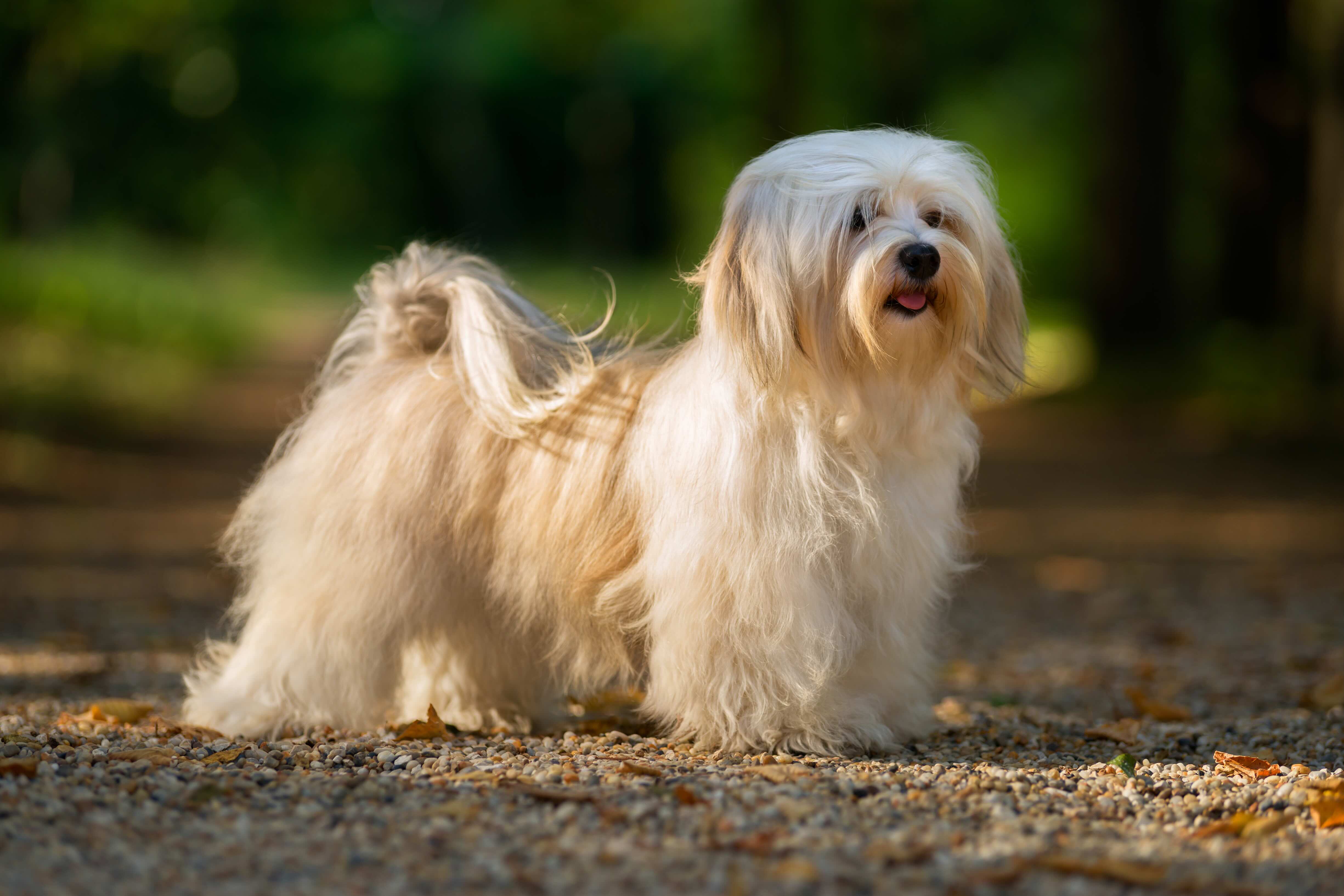
The Havanese is a wonderful family dog, and they attach to their humans quickly. They may resent being left alone and can develop separation anxiety, so they do best in homes where someone is always by their side. While usually gentle with children and other pets, early socialization and training are imperative.
Havanese dogs can do well in all sorts of homes—as long as they get routine exercise, brushing, and attention. That said, Havanese can be barky, and any neighbors with shared walls might not appreciate your dog always raising the alarm.
Havanese FAQs
How much is a Havanese puppy?
Purchasing a Havanese puppy from a breeder can cost between $800–$1,500. Dogs of certain lineage may cost more. Havanese dogs and puppies can also be found in shelters and at Havanese rescues.
Do Havanese dogs shed, or are Havanese hypoallergenic?
Havanese dogs shed less and produce less dander than many other breeds, so they are less likely to trigger allergies in some people. That said, no breed is truly “hypoallergenic,” because all dogs still produce allergens in their saliva and urine.
Some people can still be sensitive to this dog, so always spend time with the breed before bringing home a Havanese puppy.
Is a Havanese a good house dog?
A Havanese can thrive in nearly any home, and their small size makes them good apartment dogs. But remember: Even though they’re less than 1 foot tall, Havanese still require daily exercise and playtime.
Do Havanese dogs bark a lot?
Yes, Havanese dogs have a reputation for barking, so pet parents must train them to quiet down at an early age.
